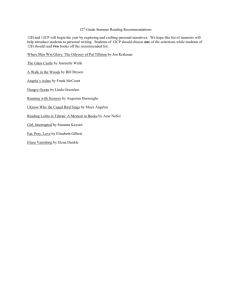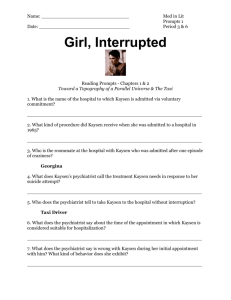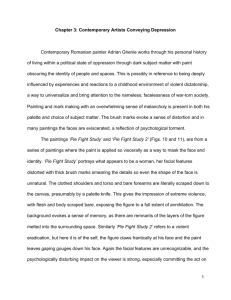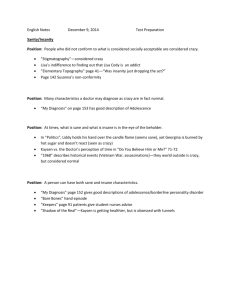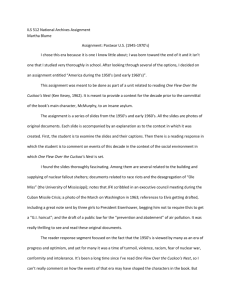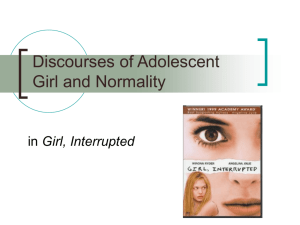The major issue I wanted to point out on my essay was that
advertisement
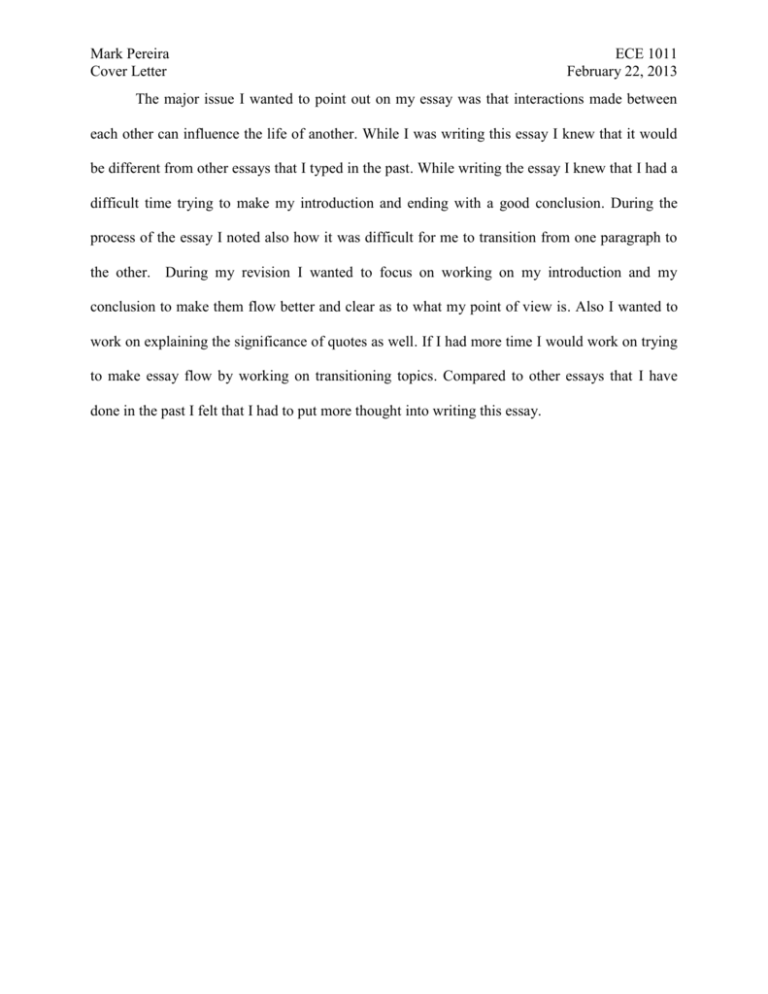
Mark Pereira Cover Letter ECE 1011 February 22, 2013 The major issue I wanted to point out on my essay was that interactions made between each other can influence the life of another. While I was writing this essay I knew that it would be different from other essays that I typed in the past. While writing the essay I knew that I had a difficult time trying to make my introduction and ending with a good conclusion. During the process of the essay I noted also how it was difficult for me to transition from one paragraph to the other. During my revision I wanted to focus on working on my introduction and my conclusion to make them flow better and clear as to what my point of view is. Also I wanted to work on explaining the significance of quotes as well. If I had more time I would work on trying to make essay flow by working on transitioning topics. Compared to other essays that I have done in the past I felt that I had to put more thought into writing this essay. Mark Pereira Melanie Zamorski ECE 1011 February 22, 2013 Man Vs Man: The Influence of Man It is in human nature for us to interact with one another and with these interactions lives can be influenced by others. Interactions such as sharing ideas, physical contact or even conflicts made with one another can cause a psychological influence on a person. In the novel Girl, Interrupted, by Susanna Kaysen, Kaysen has several interactions with patients and staff in the ward which influences Kaysen’s belief that she may or may not suffer from a mental disorder. It is demonstrated in this novel, as well as Reviving Ophelia by Mary Pipher and “Othello” by William Shakespeare, in which the interactions of humanity influences the live and outcome of another person. For example Kaysen throughout the novel does not appear to suffer from a mental disorder but is implanted with the reason to believe so. If Kaysen never made the interaction with the doctor her life would have been different from what had happen to her. Kaysen’s interactions between the patients and the staff in the ward allow her to analyze and achieve a better understanding of mental disorders. At the end of the novel she questions whether or not she should have served the two years in the ward. Her doubt shows that she feels that she was given the diagnosis of mental disorder and it’s because of that title she was treated a differently. If it was not for her diagnosis made by the doctor she could have lived a normal life. Kaysen was diagnosed with “Uncertainty about several life issues, such as self image, sexual orientation, long term goals or career choice, types of friends or lovers to have” (Kaysen 150). At the age of eighteen most teenagers would be uncertain of these issues presented in the diagnosis. Even after Kaysen leaves the ward and revisits her records she states that “I still have that uncertainty. Is this the type of friend or lover I want to have? I ask myself every time I meet someone new” (Kaysen 151). Although years have passed since her release from the ward Kaysen still continues to have uncertainties in her life which of course is normal for anyone. Kaysen brings up a point in the novel in which she reading about her diagnosis from the diagnostics and statistical manual of mental disorders. She reads that “the disorder is most commonly diagnosed in women” (Kaysen 157). Notice the choice on words used in the sentence suggesting that women are diagnosed with this disorder due to a common activity that women do which Kaysen states as “shopping sprees, shoplifting and eating binges”(Kaysen 158). Therefore it can be concluded that the mental disorder known as borderline personality disorder associates itself with sexism. The doctor who had decided to place Kaysen in the ward was basing his analysis of Kaysen in only twenty minutes but stated that he had interviewed her for three hours. Given the information from Kaysen’s perspective and the admission note which dates the hour of arrival at 11:30am, it can be concluded that the doctor whom Kaysen met for the first time made an irrational and quick diagnosis. What was interesting about the doctor’s diagnosis letter to the ward was the statement in which he said that Kaysen had a “History of suicidal attempts” (Kaysen 13) which is a lie because Kaysen had only reported that she had only once attempted a suicide which was by overdose. Another reason which shows the doctors inappropriate professionalism is when the doctor tells Kaysen “it’ll be a rest. Just for a couple of weeks, okay?”(Kaysen 8) referring to Kaysen’s stay in the ward. The doctor obviously lies again because Kaysen stays in the ward is much longer than two weeks. The interaction made between Kaysen and her doctor shows how she was manipulated to attend the ward which demonstrates how Kaysen’s life took a turn for the worse due to the actions of another person. When Kaysen goes to attend the ward the first patient she begins to discuss about is Polly. Kaysen states that Polly must have had courage to light herself on fire. “Who had the courage to burn herself? Twenty aspirin, a little slit alongside the veins of the arm, maybe even a bad half hour standing on a roof: We’ve all had those” (Kaysen 17). Kaysen is comparing the severity of Polly’s suicidal attempts to the other possible suicidal attempts she could have chosen. The perspective in which Kaysen takes Polly’s suicide is one in which there is no turning back. She says that she could have stopped taking the aspirins and faint in the street which was her exit from suicide. Kaysen realizes that unlike Polly she had the will to survive she had only gone through with the suicide because she felt that “it was only part of myself that she wanted to kill” (Kaysen 37). You can see that Kaysen is not seriously mentally damaged when compared to Polly and she learns that unlike Polly “We might get out sometime, but she was locked up forever in that body” (Kaysen 19). During her stay in the ward the nurses did their routine “checks” which was to check on each patient every five, fifteen or thirty minute intervals. Kaysen described this as being very annoying because it was a constant reminder that “another five minutes of life down the drain. And spent in this place” (Kaysen 54). The reader doesn’t fully see the effects of these “checks” on Kaysen’s psyche. It was only until the visit to the dentist in which Kaysen begins to question the dentist on how much time had gone by while she had her tooth removed. “I want to know how much time that was,” I said. See Valerie, I’ve lost some time and I need to know how much. I need to know” (Kaysen 109). Now the effects of the ward can be seen on Kaysen, she has become so accustomed to the idea of knowing how much time that has gone due to the routinely “checks” that when she loses track of time she begins to have a fit. Kaysen describes herself and the other patients as “naked, we needed protection, and the hospital protected us. Of course, the hospital had stripped us naked in the first place-but that just underscored its obligation to shelter us” (Kaysen 94). The hospital itself has taken away everything that Kaysen and the others knew. They had made her so dependent on the hospital which has made her believe that she needs to be there for protection, but of course this not true. While she was in the hospital Kaysen has an episode of depersonalization. She begins to tear at her hand because she feels that she isn’t human. She then says “I’m not safe” (Kaysen 103) and then she goes on to say “Oh, Valerie, you promised,” (Kaysen 103) meaning that the hospital was not protecting her. She begins to realize that they could not keep their promise of keeping her safe. She then concludes after the incident “now I was safe, now I was really crazy, and nobody could take me out of there” (Kaysen 104). Here Kaysen admits to being crazy but before this incident she never believed that she was which proves that she had only begun to feel crazy because of the interactions with the people and the amount of time she had been inside the ward. In the play “Othello” the protagonist Othello is influenced by the deception and lies told by Iago. Iago tells Othello “Oh, beware, my lord, of jealousy! It is the green-eyed monster which doth mock the meat it feeds on.” (William Act 3, Scene 3) Iago chooses he’s choose of words carefully here so he can make it seem that he doesn’t want to provoke Othello into becoming jealous. Similarly to Kaysen as the story goes on the condition of Othello’s mind progressively becomes engulfed with jealousy, although Kaysen wasn’t filled with jealousy her mind was approaching insanity due to the constraints and interactions in the ward. Kaysen isn’t the only character in which interactions with other people affects the outcome of their decisions and actions. Being diagnosed with a mental disorder Kaysen was viewed differently from the people in society. There is a moment in which Kaysen is looking for a job and is denied the job due to her attendance at the ward. She is given this look by the man in the shop, “He gave me a look of such terrible intimacy that I cringed. I know what you are, said his look” (Kaysen 124). The people in society know look at Kaysen completely different with disapproval because of an incident in which she had no control of. Monica, from Reviving Ophelia, dealt with a similar situation in which people laughed and disapproved of her based on her appearance. Mary Pipher talked about how Monica knew “that some people were so put off by her plain appearance that they never gave her personality a chance” (Pipher 148). Monica and Kaysen were both isolated from other people because of something that they had no control. It was because of society’s disapproval of being overweight or declared as insane which causes the people in society to deny them an opportunity to reveal their personality. In Kaysen’s final chapter of her novel she revisits a painting that she had seen before. This time it has a much larger affect on her perspective then when she had first seen it. She reads the paintings title Girl Interrupted at her Music she goes on to say “Interrupted at her music: as my life had been, interrupted in the music of being seventeen, as her life had been, snatched and fixed canvas: one moment made to stand still and to stand for all the other moments, whatever they would be or might have been. What life can recover from that?” (Kaysen 167). This the moment when Kaysen finally admits to how the ward had changed her life forever. In this quote it demonstrates how being in the ward stood for all the other moments which can be interpreted as a statement in which the possibility of having a normal life was severed. Overall in can be seen how Kaysen was not suffering from a mental illness but seemed to be ill because of the interactions between other characters. After being released from the ward Kaysen knew that she was not crazy but her life had been interrupted because of the actions made by the doctor. Kaysen did not deserve to go to the ward just because of a suicide attempt, it was the thought that she wanted to remove. Mary Pipher points out a good statement which was “adolescence is a time when development and culture put enormous stress on girls” (Pipher 151). Kaysen at her age was dealing with the stress of her parents because she was the first in her school not to graduate and culture placed a large amount of stress on her as well. Therefore it was the influence of man which decided the life of Kaysen as well as Othello and the girls described in Reviving Ophelia. Works Cited Kaysen, Susanna. Girl, Interrupted. New York: Vintage Books, 1993. Print Pipher, Mary. Reviving Ophelia Saving the Selves of Adolescent Girls. New York: Penguin Group, 1994. Print William, Shakespeare. Signet Classics Othello. New York: Penguin Group, 1963. Print
